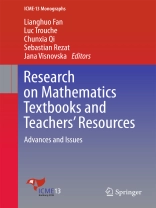This book focuses on issues related to mathematics teaching and learning resources, including mathematics textbooks, teacher guides, student learning and assessment materials, and online resources. The book highlights various theoretical and methodological approaches used to study teaching and learning resources, and addresses the areas of resources, teachers, and students at an international level.
As for the resources, the book examines the role textbooks and other curricular or learning resources play in mathematics teaching, learning, and assessment. It asks questions such as: Could we consider different types of textbooks and roles they play in teaching and learning? How does the digitalization of information and communication affect these roles? What are defining features of e-textbooks, and how could we characterize the differences between the traditional textbooks and e-textbooks?
As for the teachers, the book discusses the relationships between teachers’ individual and collective resources, and the way in which we could model such relationships. Specific questions addressed are: What is the role of teachers in developing textbooks and other teaching and learning materials? What are the relationships between resource designers and users? What are the consequences of these changing roles and relationships for the teaching of mathematics, and for teacher knowledge and professional development?
As for the students, the book explores how students, as well as their teachers, interact through resources. It raises and addresses questions such as: What are the effects of modern ICT (particularly internet) on students’ use and the design of resources? How do changing patterns of use and design affect student behaviour, learning, and relationships to the subject of mathematics?
Tabela de Conteúdo
Introduction.- Section 1 Trends in presentation of mathematics in textbooks and other resources.- Chapter 1. Open educational resources: a chance for opening mathematics teachers’ resource systems?.- Chapter 2. Textbooks used by teachers in junior high school in relation to their role.- Chapter 3. A comparative study on the presentation of geometric proof in secondary mathematics textbooks in China, Indonesia and Saudi Arabia.- Section 2 Teacher interactions with curricular and other learning resources.- Chapter 4. Examining Teachers’ Interactions with Curriculum Resource to Uncover Pedagogical Design Capacity.- Chapter 5. Disaggregating a Mathematics Teacher’s Pedagogical Design Capacity.- Chapter 6. Teachers’ selection of resources in an era of plenty: An interview study with secondary mathematics teachers in England.- Chapter 7. Teachers as designers of digital educational resources for creative mathematical thinking.- Section 3 Teachers’ collective work through resources.- Chapter 8. Curriculum support for teachers’ negotiation of meaning: A Collective Perspective.- Chapter 9. Mathematics teachers’ expertise in resources work and its development in collectives. A French and a Chinese Cases.- Chapter 10. Studying the role of context in social creativity for the design of digital resources.- Chapter 11. Uses of online trajectories and documentational trajectories: the case of Sésamath.- Section 4 Teachers and students interactions through resources.- Chapter 12. Instructional activity and student interaction with digital resources.- Chapter 13. Resourcing teachers in transition to plan for interactions with students’ ideas.- Chapter 14. Prospective Teachers’ Interactions with Interactive Diagrams: Semiotic Tools, Challenges and Well-trodden Paths.- Chapter 15. Teacher Decisions on lesson Sequence and their impact on opportunities for students to learn .- Section 5 Concluding remarks.- Chapter 16. Present research on mathematics textbooks and teachers’ resourcesin ICME: conclusion and perspectives.- Chapter 17. A global rereading of the book (exact title to be decided).- About the contributing authors.- Index.












